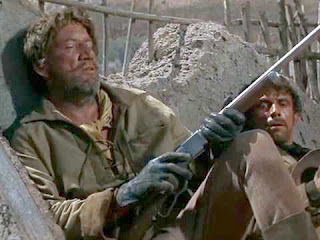Directed by John Farrow; produced by Endre Bohem
Joseph Foster (Thomas Mitchell) is a tough but honest district attorney who would do anything to put his city’s criminal bosses behind bars. He gets his chance when, after a casual remark about selling his soul to achieve his ends, he is contacted by a mysterious stranger named Nick Beal (Ray Milland). Beal is able to procure the evidence Foster needs against the crooks, but at the price of accepting it illegally. Foster’s victory propels him into state politics but each step he takes results in one more sacrifice of his morality, and at each step Beal is present to assuage Foster’s guilt. How far will the formerly upright man fall with his new ally’s help?
There is no puzzle as to who or what Nick Beal is, from the timing of his arrival to his name (‘Old Nick’ and ‘Nick Scratch’ have long referred to the Devil, while ‘Beal’ is a cleverly shortened Beëlzebub). But the fun in this well-written movie isn’t the antagonist’s identity, but how it is interpreted.
Ray Milland may have won an Oscar for his work in The Lost Weekend (1945) but I don’t think I will watch one of his performances again in the same way, after seeing him in Alias Nick Beal. His is an excellent portrayal of a villain who is simultaneously smooth talking and threatening, helpful and malevolent. Insinuation and innuendo come naturally to the character, and his confidence is too great to make him smarmy. Such movies as this don’t receive much attention when it comes to awards - they are usually seen as too light (look at the history of comedies in the Academy Awards); even so, Milland’s less spectacular but more quietly effective work here could have convincingly been nominated for an Oscar.
Also overlooked - this time by film-history - is the engaging actress Audrey Totter, who plays a down-and-out woman scooped up by Beal to tempt Foster. Totter portrayed a number of femmes fatale in the film noir genre, looking somewhat like Gloria Grahame but with greater versatility.
The script is very good, with the characters, if not well-developed, then well-depicted. There are some very good lines, such as Beal remarking that he once met somebody - implied to be a heel - on the day he died. Few facts are made explicit about Beal, which is to the movie’s advantage, as his actions and words create the person the viewer knows him to be, though in an interesting, even entertaining incarnation.
The acts that transform Foster from the decent, crusading lawyer to the corrupt and discouraged politician are credible, each small act leading to a larger. This moral disintegration is paralleled by an intellectual degradation, the kind which leads Foster to denigrate his erstwhile allies as hypocrites, not for betraying their principles, but for denouncing his own betrayal. That’s a common trait among many once-great men.
The direction is also above par, especially in showing how Beal comes and goes, and sometimes merely appears.
The story has its flaws, most notably in its resolution, which is weak. It is not inconsistent, but perhaps less than the preceding story deserved. As well, the departure of one of the major characters is too abrupt.
Over all, however, thanks to the script and above all to the performances, especially of Milland’s, Alias Nick Beal is an excellent adaptation of the Faust legend, a good study of corruption and character.
































